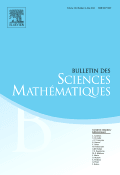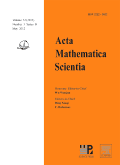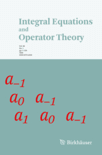
Complex Analysis and Operator Theory
Scope & Guideline
Fostering Mathematical Innovation and Application
Introduction
Aims and Scopes
- Complex Analysis:
The journal publishes research on complex functions, including their properties, behaviors, and applications within various mathematical frameworks. - Operator Theory:
A significant focus is placed on the study of operators, particularly linear operators on Hilbert and Banach spaces, exploring their spectral properties and functional calculus. - Functional Analysis:
Research on the structure and properties of function spaces, including spaces of holomorphic functions and weighted spaces, plays a crucial role in the journal's contributions. - Hankel and Toeplitz Operators:
The journal frequently addresses the theory and applications of Hankel and Toeplitz operators, particularly in relation to function spaces and complex analysis. - Fractional Calculus and Differential Operators:
There is a notable interest in fractional calculus and its applications to various differential operators, reflecting the journal's commitment to exploring advanced mathematical techniques. - Numerical Analysis and Approximation Theory:
The journal includes studies on numerical methods and approximation techniques related to operators and function spaces, highlighting practical applications of theoretical concepts. - Algebraic Structures in Analysis:
Research on the interplay between algebraic structures, such as algebras of operators and their representations, is a consistent theme, showcasing the journal's interdisciplinary approach. - Geometric Function Theory:
The exploration of geometric properties of functions, particularly in relation to holomorphic and harmonic mappings, adds a distinctive layer to the journal's focus.
Trending and Emerging
- Interdisciplinary Applications:
There is a growing trend towards applying complex analysis and operator theory to fields such as quantum mechanics, signal processing, and machine learning, indicating a shift towards practical applications. - Noncommutative Geometry:
Research involving noncommutative structures and their implications for operator theory has gained prominence, showcasing the journal's engagement with cutting-edge mathematical frameworks. - Fractional and Nonlocal Operators:
An increasing number of papers are exploring fractional and nonlocal operators, reflecting a trend towards more generalized and flexible approaches in analysis. - Operator Algebras and Their Applications:
The study of operator algebras, particularly in relation to quantum mechanics and statistical mechanics, is emerging as a significant theme, indicating a shift towards algebraic approaches. - Complex Dynamics and Iteration Theory:
Research on complex dynamical systems and iteration theory is becoming increasingly relevant, reflecting a broader interest in the behaviors of complex functions over iterations. - Advanced Spectral Theory:
There is a noticeable increase in studies focusing on advanced spectral theory, particularly involving non-self-adjoint operators and their applications in various contexts. - Geometric Analysis:
The integration of geometric methods into complex analysis and operator theory is trending, highlighting the journal's commitment to exploring the geometric aspects of mathematical analysis.
Declining or Waning
- Classical Complex Function Theory:
Research focusing solely on classical results and techniques in complex function theory appears to be waning, possibly due to the increased integration of operator theory and modern analytical methods. - Real Analysis Applications:
Papers that emphasize traditional real analysis applications have become less frequent as the journal's focus has shifted towards more complex and abstract mathematical frameworks. - Elementary Operator Theory:
Studies that solely focus on basic concepts of operator theory without integration into broader contexts or advanced applications seem to be losing traction. - Static Analysis of Operators:
Research emphasizing static properties of operators without considering dynamic aspects or applications in evolving mathematical fields is becoming less common. - Conventional Numerical Methods:
Traditional numerical methods that do not incorporate recent advancements in computational techniques or interdisciplinary applications are less frequently published.
Similar Journals

Advances in Operator Theory
Fostering Innovation in Mathematical ResearchAdvances in Operator Theory is a premier journal dedicated to the exploration of innovative and foundational research within the disciplines of Algebra and Number Theory, as well as Analysis. Published by SPRINGER BASEL AG, this journal provides a vital platform for the dissemination of high-quality research and theoretical advancements in the realm of operator theory. With a commendable impact factor and categorized in the Q3 quartile for both Algebra and Number Theory and Analysis in 2023, it holds significant standing in the Scopus rankings, substantiating its relevance in the mathematical community. The journal encourages open discussions and lively exchange of ideas among researchers, professionals, and students alike, fostering an environment conducive to scholarly growth and collaboration. Based in Iran at PICASSOPLATZ 4, BASEL 4052, SWITZERLAND, it has been actively publishing since 2016, making substantial contributions to its field through rigorous peer-reviewed articles. As an essential resource for anyone invested in the forefront of mathematical research, Advances in Operator Theory continues to illuminate complex topics and inspire future inquiries.

Computational Methods and Function Theory
Innovating solutions for complex mathematical challenges.Computational Methods and Function Theory is a distinguished journal published by SPRINGER HEIDELBERG, dedicated to advancing the fields of computational mathematics and functional analysis. With its ISSN 1617-9447 and E-ISSN 2195-3724, this journal serves as a vital resource for researchers, professionals, and students seeking to explore state-of-the-art methodologies and theoretical developments from 2011 to 2024. Its robust ranking positions it in the Q3 category for Analysis and Computational Theory and Mathematics, and Q2 for Applied Mathematics, reflecting the journal's influence and credibility within the scientific community. Residing in Germany, the journal promotes open dialogue and innovative solutions to complex mathematical problems, making significant contributions to both theoretical and applied disciplines. Its impact is evidenced by strong Scopus rankings, asserting its relevance and rigorous peer-review processes, which ensure high-quality publications. This journal stands as a key platform for disseminating groundbreaking research and fostering collaboration across disciplines.

BULLETIN DES SCIENCES MATHEMATIQUES
Charting the Course of Future Mathematical DiscoveriesBULLETIN DES SCIENCES MATHEMATIQUES, published by Elsevier, is an esteemed journal dedicated to the field of mathematics, particularly excelling in miscellaneous mathematical disciplines. With an impressive Q1 category quartile ranking in 2023, it positions itself among the top tier of journals in its field, reflecting its commitment to high-quality research and scholarship. The journal operates under the ISSN 0007-4497 and E-ISSN 1952-4773, facilitating a robust platform for sharing pioneering mathematical theories and applications. Researchers, professionals, and students will find invaluable insights and comprehensive studies here, aiding in the advancement of mathematical knowledge and fostering collaboration across disciplines. The journal's comprehensive scope includes a broad range of topics, ensuring it remains at the forefront of mathematical research until its convergence in 2024. Whether you are seeking to publish groundbreaking findings or to stay updated with the latest advancements in mathematics, the BULLETIN DES SCIENCES MATHEMATIQUES is a definitive resource for the academic community.

ACTA MATHEMATICA SCIENTIA
Pioneering Discoveries in Mathematics and AstronomyACTA MATHEMATICA SCIENTIA is a reputable academic journal published by Springer, primarily focusing on the interdisciplinary fields of mathematics and physics. With an ISSN of 0252-9602 and an E-ISSN of 1572-9087, the journal has established itself as an influential platform for researchers and professionals seeking to disseminate novel findings in these domains. Based in the Netherlands, the journal holds a commendable Q2 category ranking in both Mathematics and Physics & Astronomy for 2023, reflecting its significance in the academic community. With a focus extending from 1996 to 2024, ACTA MATHEMATICA SCIENTIA serves as a vital resource for scholars, offering insights that bridge theoretical and applied sciences. Published under rigorous peer review, the journal fosters a robust scholarly dialogue and encourages innovative research that challenges existing paradigms. While access is not open, the journal's contributions are of paramount importance for advancing knowledge in the mathematical sciences and their applications in physical contexts.

INTEGRAL EQUATIONS AND OPERATOR THEORY
Catalyzing growth in integral equations and operator studies.INTEGRAL EQUATIONS AND OPERATOR THEORY, published by SPRINGER BASEL AG, stands at the forefront of research in the fields of algebra, number theory, and analysis, with an esteemed categorization of Q2 in both disciplines as of 2023. With its ISSN 0378-620X and E-ISSN 1420-8989, this journal not only maintains a rigorous standard for scholarly contributions but also offers a vital platform for discourse on theoretical and applied aspects of integral equations and operator theory. Established in 1978, it has nurtured academic growth and innovation, with contributions continuing up to 2024. The journal holds respectable Scopus rankings, placed 43rd out of 119 in Algebra and Number Theory, and 110th out of 193 in Analysis, establishing its relevance and impact within the mathematical community. Researchers, professionals, and students alike will find INTEGRAL EQUATIONS AND OPERATOR THEORY to be an invaluable resource for advancing knowledge, fostering collaboration, and inspiring future studies within these critical areas of mathematics.

ACTA SCIENTIARUM MATHEMATICARUM
Bridging Theory and Application in MathematicsACTA SCIENTIARUM MATHEMATICARUM, published by SPRINGER BIRKHAUSER in Switzerland, is a distinguished journal focusing on the fields of mathematical analysis and applied mathematics. With an ISSN of 0001-6969 and an E-ISSN of 2064-8316, this journal serves as a critical platform for disseminating high-quality research that bridges theoretical and practical aspects of mathematics. Although currently categorized in the Q3 quartile for both Analysis and Applied Mathematics as of 2023, the journal strives to enhance its impact on the mathematical community by offering a perfect blend of rigorous research and innovative applications. Researchers, professionals, and students can benefit from the journal’s commitment to advancing knowledge in mathematics, despite the absence of open-access options. The mailing address for correspondences is 233 SPRING STREET, 6TH FLOOR, NEW YORK, NY 10013. As mathematics continues to evolve, ACTA SCIENTIARUM MATHEMATICARUM positions itself as a valuable resource for those looking to contribute to and stay informed about the latest developments in this vibrant field.

Sahand Communications in Mathematical Analysis
Elevating research standards in mathematical analysis.Sahand Communications in Mathematical Analysis is a distinguished open-access journal published by the University of Maragheh in Iran, dedicated to the field of mathematical analysis and its applied branches. Since its inception in 2014, the journal has provided a valuable platform for researchers to disseminate significant findings in areas ranging from analytical methods to numerical analysis and applied mathematics. Despite its relatively recent establishment, the journal has quickly gained recognition, noted for its Q3 rankings in both Applied Mathematics and Numerical Analysis categories, and its Q4 ranking in Analysis for 2023. With an ambition to foster innovative research and facilitate scholarly dialogue, Sahand Communications in Mathematical Analysis aims to support the global mathematical community by ensuring unrestricted access to high-quality research outputs. Researchers, professionals, and students can look forward to engaging content that pushes the boundaries of mathematical inquiry through its open-access model, thus enhancing the accessibility and reach of critical mathematical discussions.

POSITIVITY
Shaping the Future of Analysis and ComputationPOSITIVITY is a distinguished journal published by Springer, focusing on cutting-edge research in the realms of Mathematics, Analysis, and Theoretical Computer Science. Since its inception in 1997, the journal has fostered intellectual rigor and innovation, catering to a diverse audience of researchers, professionals, and students alike. With an esteemed Q2 ranking in 2023 across multiple categories including General Mathematics, Analysis, and Theoretical Computer Science, POSITIVITY serves as a significant platform for disseminating high-impact findings that advance knowledge in these fields. Though it does not operate under an Open Access model, the journal provides critical insights that contribute to its commendable standing, reflected in its Scopus rankings, which highlight the journal's influence within the academic community. The ongoing publication until 2024 ensures that POSITIVITY remains at the forefront of mathematical discourse, making it an invaluable resource for those dedicated to pushing the boundaries of theoretical and applied mathematics.

POTENTIAL ANALYSIS
Illuminating the Path of Potential ResearchPOTENTIAL ANALYSIS is a prestigious academic journal dedicated to the field of mathematical analysis, published by Springer. With the ISSN 0926-2601 and E-ISSN 1572-929X, this journal serves as a pivotal platform for scholars to disseminate cutting-edge research and advancements in potential theory, providing insights that bridge theoretical mathematics and applied analysis. Since its inception in 1992, POTENTIAL ANALYSIS has consistently maintained a high impact factor, boasting a Q1 rating in the 2023 category of Analysis, signifying its influence and reputation among its peers. It ranks 76 out of 193 in the Mathematics Analysis category in Scopus, placing it within the 60th percentile, which attests to the journal's commitment to quality and rigorous peer-review processes. While access to its articles is not open, it remains an essential resource for researchers, professionals, and students aiming to expand their understanding of potential theory and its applications in various fields. The journal's ongoing publication until 2024 promises a continual flow of innovative research, underpinning its role as an invaluable asset in the mathematical community.

Rendiconti del Circolo Matematico di Palermo
Navigating the Evolution of Mathematical Ideas.Rendiconti del Circolo Matematico di Palermo, published by SPRINGER-VERLAG ITALIA SRL, is a revered journal in the field of mathematics, emphasizing the cultivation and dissemination of mathematical knowledge since its inception in 1887. With its ISSN 0009-725X and E-ISSN 1973-4409, this esteemed publication has continued to thrive, showcasing innovative research, comprehensive reviews, and thoughtful discussions from diverse areas in mathematics, particularly in its Q2 ranking within the miscellaneous mathematics category. Its historical significance is underscored by its convergence of publications across numerous years, including its notable periods from 1887 to 1916, 1919 to 1938, and beyond, effectively capturing the evolution of mathematical thought. Though not open access, the journal remains an essential resource for researchers, professionals, and students aiming to stay updated with the latest advancements and methodologies in the ever-evolving landscape of mathematics. With its Scopus rank placing it in the top 25th percentile, Rendiconti del Circolo Matematico di Palermo continues to be a cornerstone for scholarly dialogue and development in its domain.